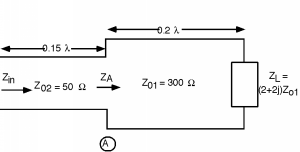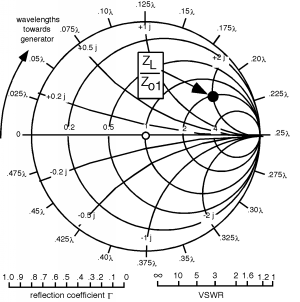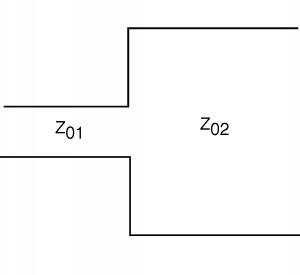6.17: Odds and Ends
- Page ID
- 88589
Just a few odds and ends. Consider Figure \(\PageIndex{1}\), which is called a "cascaded line" problem. These are problems where we have two different transmission lines, with different characteristic impedances. Since we will give all of the distances in wavelengths, λ, we will assume that the λ we are talking about is the appropriate one for the line involved. If the phase velocities on the two lines is the same, then the physical lengths would correspond as well. The approach is relatively straight-forward. First let's plot on the Smith Chart, in Figure \(\PageIndex{2}\). Then we have to rotate so that we can find , the normalized impedance at point A, the junction between the two lines in Figure \(\PageIndex{3}\).

Figure \(\PageIndex{1}\): Cascaded line

Figure \(\PageIndex{2}\): Smith Diagram
Thus, we find . Now we have to renormalize the impedance so we can move to the line with the new impedance . Since , . This is the load for the second length of line, so let's find , which is easily found to be , so this can be plotted on the Smith Chart in Figure \(\PageIndex{4}\). Now we have to rotate around another so that we can find . This appear to have a value of about , so , as shown in Figure \(\PageIndex{5}\).

Figure \(\PageIndex{3}\): Towards the generator

Figure \(\PageIndex{4}\): More Smith Charts

Figure \(\PageIndex{5}\): Even more Smith Charts
There is one application of the cascaded line problem that is used quite a bit in practice. Consider the following: We assume that we have a matched line with impedance and we connect it to another line whose impedance is as shown in Figure \(\PageIndex{6}\). If we connect the two of them together directly, we will have a reflection coefficient at the junction given by

Figure \(\PageIndex{6}\): Simplified cascaded line
Now let's imagine that we have inserted a section of line with length and impedance as in Figure \(\PageIndex{7}\). At point \(A\), the junction between the first line and the matching section, we can find the normalized impedance as

Figure \(\PageIndex{7}\): Another cascaded line
We take this impedence and rotate around on the Smith Chart to find
where we have taken advantage of the fact that when we go half way around the Smith Chart, the impedance we get is just the inverse of what we had originally (half way around turns into ).
Thus
If we want to have a match for line with impedence , then should equal and hence:
or
This piece of line is called a quarter wave matching section and is a convenient way to connect two lines of different impedance.


